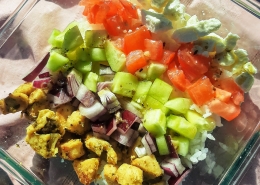Carne Asada Seitan (Vegan)
This dish is a plant-based twist on the classic taco filling, carne asada. Did you decide to eat less meat in the new year? Whether you’re trying to stay true to your resolution or you’re a plant-based eater looking for a change of pace, this recipe might be exactly what you’re looking for. It’s deliciously reminiscent of your favorite taco stand and fills you up with plenty of protein. Inspired by a dish my partner makes quite often, this recipe is tried-and-true, and I hope you’ll enjoy it too!
Ingredients for seitan:
¾ cup vital wheat gluten flour
¼ cup flour
¾ cup water
Ingredients for marinade:
1 lime
2 cloves garlic
1 orange
1/2 cup chopped fresh cilantro
1/2 teaspoon salt
1/4 teaspoon black pepper
¼ cup olive oil
1 T cumin
½ T paprika
½ T chili powder
½ T italian herbs
Instructions:
In a medium mixing bowl, add your vital wheat gluten, flour, and water. Mix until a dough forms and knead with your hands for at least 3 minutes. Allow it to rest for 5 minutes before kneading it again for another 3 minutes. Set aside while you prepare to steam the dough.
Bring a large pot of water, about ¼ of the way full, to a boil. Find a metal colander or steamer basket that will fit on top of the pot without falling inside. If you have a pot with a steamer attachment, that appliance will also work. Spray your colander or steamer basket with non-stick cooking spray and place it on top of your pot.
Put your seitan dough into the steamer basket or colander. Cover it and allow it to steam on medium-high heat for 35 minutes. Check on it occasionally to make sure the water in the pot has not boiled off.
While your seitan is steaming, you can make the marinade.
In a small mixing bowl, add your chili powder, paprika, cumin, italian herbs, salt, black pepper, and olive oil.
Mince your garlic cloves and chop your cilantro. Add them to your mixing bowl.
Add the juice from your orange and lime into the mixing bowl. If you don’t own a citrus juicer, I recommend cutting them into 4 segments and squeezing them with your hands.
Stir your marinade until it is well combined. Set aside until your seitan has finished steaming.
Once your seitan is done steaming, allow it to cool down before you prepare it.
When your seitan has cooled, cut it into strips of your desired thickness. I recommended cutting it into ½ inch strips and cutting those strips in half.
Add your seitan to your marinade and stir until every piece is covered in the marinade. Allow it to rest in the refrigerator for at least 30 minutes.
Remove your seitan from the marinade and cook it in a skillet on medium heat until all the liquid cooks off and it becomes crispy, about 10 minutes.
Serve over rice or soft taco shells and enjoy!

 Many people are aiming to scale down their meat consumption or follow a plant-based diet, but don’t want to miss out on their favorite foods. Meat alternatives are a great way to achieve the flavor and texture you crave without consuming animal products. Plant-based sausages, deli meat slices are just some of the products we offer alongside alternatives to bacon, chicken, and ground beef. These products all use tofu, seitan, or tempeh to form the base of their products. While these products have more ingredients, this is because they’re flavored using different spices, sauces, or seasonings to imitate the flavor of specific meats. Meat alternatives may also undergo more processing than plain tofu, tempeh, or seitan to create the right texture and imitate a specific meat. Some meat alternatives add other whole-food ingredients in addition to spices to add flavor and texture using onions, carrots, tomatoes, mushrooms and even apples.
Many people are aiming to scale down their meat consumption or follow a plant-based diet, but don’t want to miss out on their favorite foods. Meat alternatives are a great way to achieve the flavor and texture you crave without consuming animal products. Plant-based sausages, deli meat slices are just some of the products we offer alongside alternatives to bacon, chicken, and ground beef. These products all use tofu, seitan, or tempeh to form the base of their products. While these products have more ingredients, this is because they’re flavored using different spices, sauces, or seasonings to imitate the flavor of specific meats. Meat alternatives may also undergo more processing than plain tofu, tempeh, or seitan to create the right texture and imitate a specific meat. Some meat alternatives add other whole-food ingredients in addition to spices to add flavor and texture using onions, carrots, tomatoes, mushrooms and even apples.










